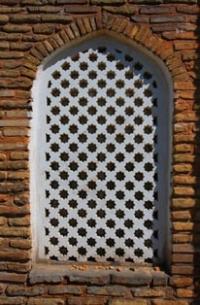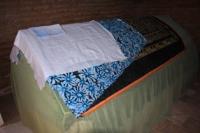Вы здесь
Dervish-ata grave in Sairam.


Sights of Sairam.
“At the Balogardan Bab cemetery there is the grave of Hazret Ismoil ata. He is the son of Muhammad Dervish ata"
"Risolai Sarem-Isfizhob."
A trip from Sairam to Shymkent.
In the books of Khoja Ahmed Yassawi and Suleiman Bakirgoni, one can find verses by Muhammad Dervish. In style, they are similar to the poetry of Ahmed Yassawi, and in essence relate to Sufism. In “Risolai Sarem-Isfizhob” it is said: “At the Balogardan Bab cemetery there is the grave of Hazret Ismoil ata.
He is the son of Muhammad Dervish ata. " In the book of Muhammad Kuprilozad “Turk adabiyetida ilk mutasavvuflar” and in the eighteen-volume “Turk-Islamic Encyclopedic Dictionary” the famous Muhammad Khoja who studied in Khorezm is mentioned.
Among the pilgrims who visited the grave of Dervish aha, there were many Khorezmians who worshiped him. There is a legend explaining the extreme popularity of Dervish ata in Khorezm. During the raids, Kalmyks, among other riches, carried away rare books.
One of the camels, loaded with books, died on the way, and an illiterate Kalmyk driver drove them into the Amu Darya river. Among them was the book of Muhammad Dervish. Khorezmians found a bale of books and therefore became fans of Muhammad Dervish.
There is another legend in Shymkent. Once Khoja Ahmed Yassavi gathered in holy Bukhara to replenish his knowledge. Upon learning of this, Dervish Ata was surprised: “Can Ahmed leave his mother alone?” In response, Khoja Ahmed Yassawi climbed onto a wall made of buttermilk (clay) and, hitting it lightly with a twig, spurred: "Chu."
The wall began to move and pulled the city along to the west. They say that Dervish Ata asked for forgiveness from Khoja Ahmed Yassawi. According to Academician V. Bartold, this meeting in the city could have taken place 900 years ago.
Until 1972, the grave of Muhammad Dervish ata was located in the Otkumar area. There was also a mausoleum, which was surrounded by centuries-old plane trees and springs. Passengers passing by dismounted here and recited prayers.
In 1972, by order of the authorities, the grave was unearthed, the relics and holy soil were transferred to the Kashka cemetery. According to several people and Imam Shukurillo Khoji, then, despite a clear summer day, heavy rain suddenly poured.
Authority:
"Code of monuments of the South Kazakhstan region." Architectural and archaeological heritage of the South Kazakhstan region. In the framework of the regional program "Cultural Heritage". http://www.farsah.kz
Photos
Alexander Petrov.







